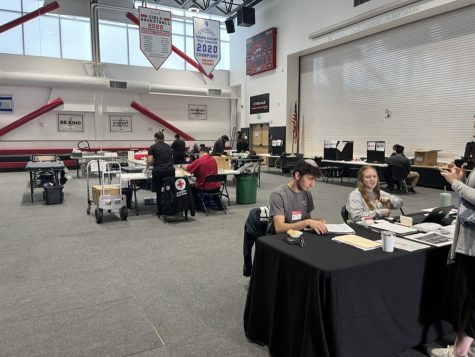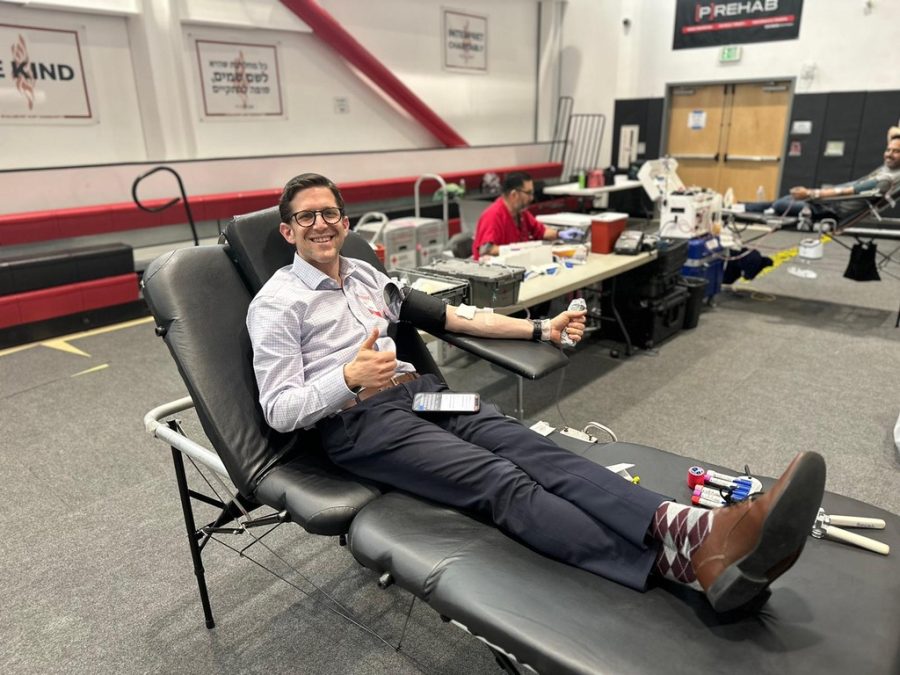LEADING: Head of School Rabbi David Block was one of the 51 people who donated blood at this year’s spring drive April 27.
Spring blood drive goes overtime, five donors turned away
Amount collected exceeds goals anyway with 49 units, organizers may ask for more beds next year
As a result of time and other factors, five volunteers were turned away from this year’s blood drive – but organizers’ goal of 45 donors was still exceeded because 51 people were able to donate.
In fact, even though donors were turned away, the blood drive held April 27 collected 11 more units than last time – a total of 49 units of blood, compared to 38 taken in at last fall’s drive, according to event organizers, who are planning improvements to do even better next time.
Senior Josh Askari and junior Rachel Blumofe oversaw both drives, with the help of sophomore volunteer Leah Cohen and American Red Cross Interim District Manager Mr. Jayson Buckley. According to Rachel and Leah, who are likely to co-run the event next year, this drive saw more advertising, both on Schoology and in grade group chats, which prompted more students to want to donate, whether it was through an appointment or as walk-ins.
“We collected too much blood – which is a good problem to have, but it also meant that the wait time was longer for those who were pre-scheduled,” said Rachel.
The delays and turn-aways, they said, were caused by a mix of more walk-ins, people not filling out their donation forms beforehand, and appointments taking longer than expected.
Rachel and Leah said the five people turned away from donating – one of them having an appointment – could have donated an additional five pints of blood.
Mr. Buckley, who said he has worked with numerous high school blood drives, said it’s common for high school drives to run out of time.
“We’re basically scheduled for a six-hour blood drive, and we can see a certain amount of people in that six hours depending on the number of staff we have at a drive,” said Mr. Buckley in an interview.
Because the nurses had started at nine in the morning and ended at 3:30 p.m., it wasn’t possible for the nurses to stay any longer to accept more people, Josh said. As a result, they had to reject a few donors. Since the nurses were only being paid a certain amount for how long they were working, it wasn’t fair for them to have to stay any longer.
“We literally didn’t have time for them,” said Josh of those who’d been turned away. “The nursing staff ended up staying extra 30 minutes just because we had so many people.”
Another problem had to do with people filling out forms on-site instead of beforehand. Before someone donates blood, they have to fill out a 50-question yes-or-no health questionnaire. According to Mr. Buckley, oftentimes at high schools, the volunteers don’t fill out these sheets until they arrive at their appointment. This can delay the appointment by 15 minutes, causing a chain reaction.

Josh said that most of the volunteers who filled out their forms at the drive itself were either first-time donors or walk-ins. He also said most students who had an appointment did complete their forms in advance.
There was a large number of walk-ins this year, he said, delaying appointment times and resulting in the five volunteers being turned away.
Rachel said she was considering proposing a rule change for next year that would only allow those with an appointment to donate.
Also, for the future the two plan on requesting from Mr. Buckley an additional nurse and bed to help speed things up and increase capacity.
Senior Molly Menashe, the one rejected donor with an appointment, said she signed up for the blood drive a week before and was turned away shortly after she arrived at the gym. But she wasn’t upset that she wasn’t able to donate.
“I mean I’m glad that they got all the blood that they needed,” said Molly. “I think that it’s amazing that that many people were able to donate and I didn’t get to, but I’m sure there will be more opportunities in the future.”
According to the U.S. Department of Health and Human Services, the 49 pints collected in April’s drive can save up to 147 lives.
Junior Nettie Wolkind, who has now donated blood four times, said she felt a little lightheaded afterwards, but that the experience isn’t as nerve-racking as people think it would be.
“It wasn’t awful,” said Nettie. “The build-up in your head is worse than the actual event. It’s a needle, it’s a shot, it’s nothing awful.”
Rowan Gever, a sophomore and first-time donor, wanted to donate in the last blood drive in 2022 but wasn’t eligible. This time around, he was nervous but happy he contributed.
“I mean, I knew it was going to be a lot of blood, but I didn’t realize how much it actually looked like,” Rowan said.
Rowan said he completely felt normal afterward since he drank and ate a substantial amount before giving blood. According to the American Red Cross, eating foods that are high in iron and drinking lots of fluids prior to donating, can improve one’s reaction to giving blood.
Another first-time donor, Leah Cohen, who may take over for Josh next year, felt accomplished after donating blood for the first time and is looking forward to repeating the process in the future.
“I was really excited,” said Leah. “I was kind of jumping around in my chair, I was really excited to be able to save people’s lives. I think it’s a great opportunity.”
Before the drive, Leah had thought giving blood would be a much bigger ordeal, and she was surprised at how painless the experience was, saying she barely felt it when the needle went in.
The youngest someone can be to donate is 16. This means that most freshmen and some sophomores are ineligible. In addition, ill people are not allowed to donate blood, whether it’s a common cold or something more serious.
According to the American Red Cross, that’s because someone with leukemia or lymphoma could potentially spread the disease through donated blood. Also, other diseases such as hemophilia or STDs make someone ineligible as they can be transmitted through blood plasma.
After the drive, Josh and Rachel said the blood was taken in a truck by the American Red Cross and later distributed to hospitals, where it is used to save lives both in emergencies and pre-planned surgeries.
There haven’t always been time issues at blood drives. In the two 2020 blood drives, according to former three-year blood drive leader Joey Blumofe ‘21, Rachel’s brother, 54 and 56 donors were recorded, Joey said in an interview.
Mr. Buckley of the Red Cross commended Josh and Rachel for their hard work on this year’s two drives, and also had a word of advice for future leaders to prevent people from having to be turned away.
“What I would recommend is ensuring that everyone shows up on time to their appointment,” Mr. Buckley said, “and walk-ins are limited to replace donors that don’t show up to their appointments.”
Rachel said the hardest part of the blood drive is getting people to sign up, and that due to the number of no-shows the drive gets every year, it helps if people sign up in advance.
“It’s really important that those people who are willing to give, do give, and in order for other people who do need it,” said Rachel.
Josh, who is interested in a career in the medical field, said that since the first time he donated blood at age 16, he has felt a passion for the movement.
“This is the best thing that I saw, and when I was provided the opportunity, I donated, and when I donated, I was like, oh wow I want to be more involved,” said Josh.
